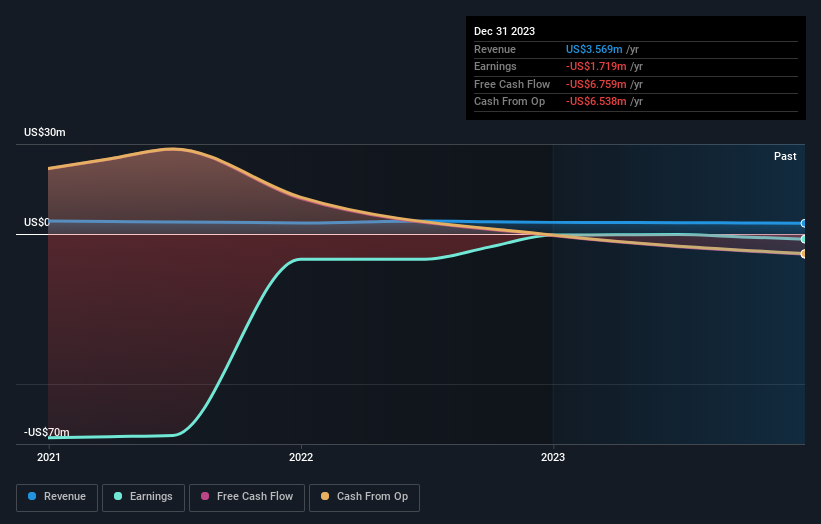Key Insights
- Significant insider control over TROOPS implies vested interests in company growth
- 51% of the business is held by the top 2 shareholders
- Using data from company's past performance alongside ownership research, one can better assess the future performance of a company
Every investor in TROOPS, Inc. (NASDAQ:TROO) should be aware of the most powerful shareholder groups. With 52% stake, individual insiders possess the maximum shares in the company. That is, the group stands to benefit the most if the stock rises (or lose the most if there is a downturn).
As a result, insiders scored the highest last week as the company hit US$484m market cap following a 15% gain in the stock.
In the chart below, we zoom in on the different ownership groups of TROOPS.

What Does The Lack Of Institutional Ownership Tell Us About TROOPS?
 Small companies that are not very actively traded often lack institutional investors, but it's less common to see large companies without them.
Small companies that are not very actively traded often lack institutional investors, but it's less common to see large companies without them.
There could be various reasons why no institutions own shares in a company. Typically, small, newly listed companies don't attract much attention from fund managers, because it would not be possible for large fund managers to build a meaningful position in the company. Alternatively, there might be something about the company that has kept institutional investors away. TROOPS might not have the sort of past performance institutions are looking for, or perhaps they simply have not studied the business closely.

TROOPS is not owned by hedge funds. Looking at our data, we can see that the largest shareholder is Kai Kai Kwok with 29% of shares outstanding. Chi-Yu Leung is the second largest shareholder owning 23% of common stock, and Damian Thurnheer holds about 0.6% of the company stock.
After doing some more digging, we found that the top 2 shareholders collectively control more than half of the company's shares, implying that they have considerable power to influence the company's decisions.
Researching institutional ownership is a good way to gauge and filter a stock's expected performance. The same can be achieved by studying analyst sentiments. We're not picking up on any analyst coverage of the stock at the moment, so the company is unlikely to be widely held.
Insider Ownership Of TROOPS
The definition of an insider can differ slightly between different countries, but members of the board of directors always count. Management ultimately answers to the board. However, it is not uncommon for managers to be executive board members, especially if they are a founder or the CEO.
Most consider insider ownership a positive because it can indicate the board is well aligned with other shareholders. However, on some occasions too much power is concentrated within this group.
Our most recent data indicates that insiders own the majority of TROOPS, Inc.. This means they can collectively make decisions for the company. So they have a US$251m stake in this US$484m business. Most would argue this is a positive, showing strong alignment with shareholders. You can click here to see if those insiders have been buying or selling.
General Public Ownership
The general public-- including retail investors -- own 48% stake in the company, and hence can't easily be ignored. This size of ownership, while considerable, may not be enough to change company policy if the decision is not in sync with other large shareholders.
Next Steps:
It's always worth thinking about the different groups who own shares in a company. But to understand TROOPS better, we need to consider many other factors. Case in point: We've spotted 2 warning signs for TROOPS you should be aware of, and 1 of them is a bit concerning.
If you would prefer check out another company -- one with potentially superior financials -- then do not miss this free list of interesting companies, backed by strong financial data.
NB: Figures in this article are calculated using data from the last twelve months, which refer to the 12-month period ending on the last date of the month the financial statement is dated. This may not be consistent with full year annual report figures.
Have feedback on this article? Concerned about the content? Get in touch with us directly. Alternatively, email editorial-team (at) simplywallst.com.
This article by Simply Wall St is general in nature. We provide commentary based on historical data and analyst forecasts only using an unbiased methodology and our articles are not intended to be financial advice. It does not constitute a recommendation to buy or sell any stock, and does not take account of your objectives, or your financial situation. We aim to bring you long-term focused analysis driven by fundamental data. Note that our analysis may not factor in the latest price-sensitive company announcements or qualitative material. Simply Wall St has no position in any stocks mentioned.
